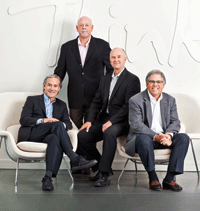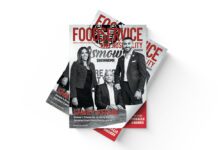There’s justifiable pride in Chris Compton’s voice when he says, “Drive down Main Street in Anywhere, Canada, and Maple Leaf Foodservice is the major supplier to most of the operators you pass.” The SVP of Sales & Marketing for the Toronto-based Maple Leaf Foodservice has every right to be proud of a Canadian company that has made such a significant impact in the industry.
Indeed, the company that faced a potentially disastrous battle with Listeria only five years ago has emerged stronger than ever and become a global leader in product innovation and food safety. Michael McCain, president & CEO of Maple Leaf Foods, will tell you it’s because this is a company “populated by great people.”
In fact, when asked what gives him greatest pride in the achievements of his company, McCain doesn’t talk about awards, though there have been many, or about financial success — reflected in a growth rate last year of four per cent in the foodservice division. Instead, he talks about the people. “About 15 years ago, collectively, we made a commitment across the organization to a leadership-values-based culture and to attract the very best talent in the industry to forward that culture,” says McCain. “I believe Maple Leaf has devoted greater resources and effort and focus behind the development of our people than most companies in the country.” Programs — from entry-level, broad orientation training in multiple disciplines, to mentoring and coaching programs and active experiential development of individuals — have fostered growth and development of leadership skills. A joint-venture partnership with Ivey School of Business at the University of Western Ontario offers an academy of leadership training.
It’s not surprising that in 2007, and again in 2010, Maple Leaf was named one of Canada’s 10 Most Admired Corporate Cultures — a program recognizing leading Canadian organizations for having a culture that has helped them enhance performance and sustain a competitive advantage.
That culture has also encouraged involvement in charitable outreach, ranging from local programs such as Eva’s Initiatives — assisting young people living on the street to get back to a better life — to global aid through Unicef. Last year, this amounted to nearly $1.5 million in cash and product donations.
But a company’s success requires investment in both its people and its operations. In 2007, recognizing that it was dealing with a 50-year-old distribution and supply system, Maple Leaf
Foods undertook a billion-dollar transformation. “We’re five-and-a-half years into a seven-year journey. It’s been a gruelling, difficult transition as we have essentially rebuilt our company while maintaining our focus on what’s really sustainable,” says McCain. “We have built a new supply chain while simultaneously innovating in the marketplace.”
Innovation is a hallmark of the company’s strategy. In the past year, Maple Leaf was recognized for developing wieners thin enough to stuff a pizza crust, earning Yum Brandz’ Supplier of the Year as well as Product Innovation Supplier of the Year awards. Sysco named Maple Leaf its Healthcare Supplier of the Year for its industry-leading position on sodium reduction and fat reduction aimed particularly at healthcare and educational foodservice.
The company has made a significant commitment to healthy food, says McCain. “We’re taking all the bad things out and putting good things in — reducing sodium and trans fat and reducing less nutritious components of food supply is part of that.” Last spring, it introduced PureLink, which uses robotics to substantially improve food safety and “performance” of sausage products.
And, there’s determination that food safety will never be a threat. To that end, the company has shared its experience and know-how. For the past five years, more than 100 companies and organizations have gathered at Maple Leaf’s invitation to discuss pressing concerns at its annual Food Safety Symposium held at the ThinkFood! Centre of Excellence facilities in Mississauga, Ont.
While investing in innovative new technologies to improve safety, quality and efficiency, the word innovation seems most apt when applied to its customers. Indeed, innovating has been a hallmark of the company’s approach to them. “It’s about sitting down with our customers and determining what they need rather than what we have to sell,” says Compton, rapid-firing a host of possible challenges that might require creativity from his team. “It could be about a process, performance, food safety, allergens, lower sodium, speed of preparation, more portable for take-out traffic; or about the way we make it and how they use it.”
The foodservice division has launched a comprehensive website dedicated to operators only. But, while it may reflect the vast array of products, with more than 1,500 SKUs available through the company, it’s the next step that really drives customer satisfaction, says Compton. That’s where the 95 sales staff in the foodservice division roll up their collective sleeves and sit down with the company’s dedicated product development specialists.
For example, when a major national customer wanted a healthy, natural hotdog with no artificial ingredients, Maple Leaf developed another version of its Natural Selections offering. “It allowed them to upscale and sell a better-for-you product,” says Compton. “We ensured that it met their taste and performance criteria.”
Probably the best illustration of this collaboration with customers might be Maple Leaf’s work with one of Canada’s other iconic companies. The team has worked with Tim Hortons for about 35 years. “Maple Leaf is a key supplier partner in our evolution. And, I choose those words carefully; they are a strategic partner, a role they take very seriously,” says David Clanachan, COO of Tim Hortons Inc. “We look on their R&D department as an extension of ours. They have access to our cooking equipment, and they do a great job of understanding how any new product will work in our restaurants.”
The foodservice industry is still struggling for a stronger share of the food dollar. And, every battle requires as many resources as one can muster. “We are happiest when we can deliver on a project. A happier customer in a restaurant, or healthier meals in a school or healthcare facility, those are our greatest wins,” says Compton.
Tim Hortons’ Clanachan sums it up best: “They’re innovative, they’re solutions providers, they work with the people they supply and take a real interest in their business. Anyone can sell boxes, but that process is transactional. Maple Leaf has become a partner. It’s what all companies doing business should aspire to.”
Photo by Margaret Mulligan



















